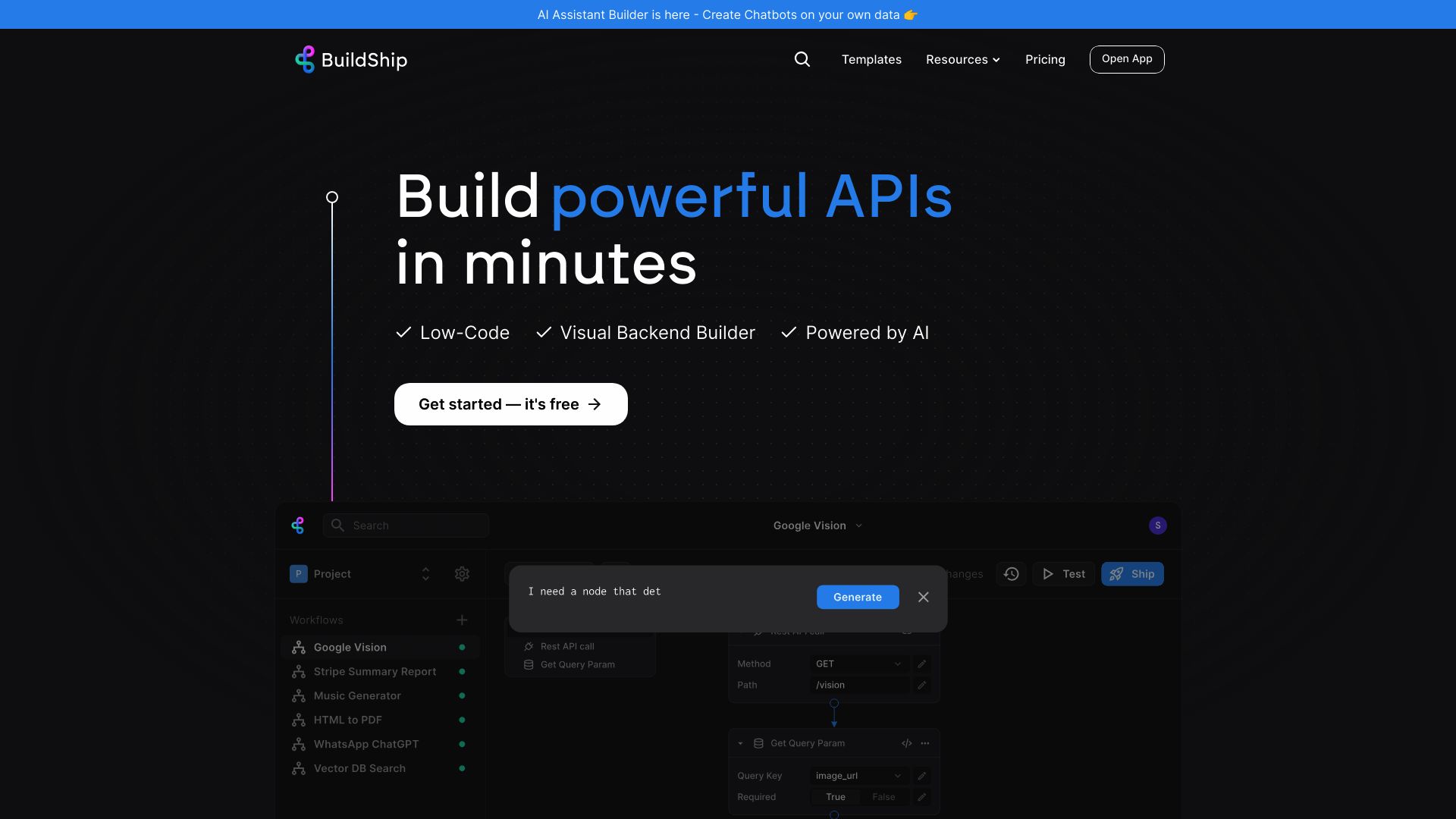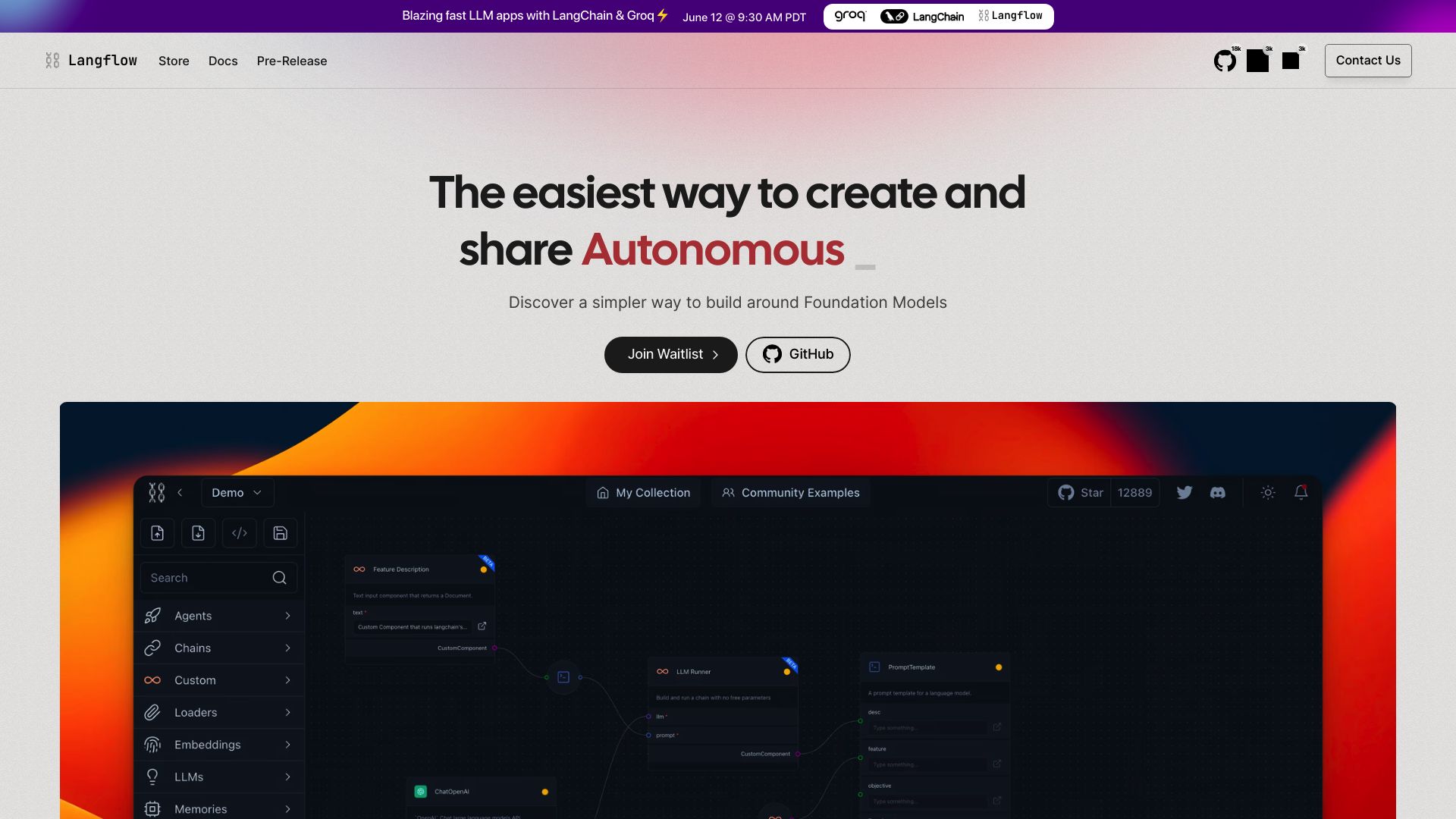AI workflow creation tools empower businesses to harness cutting-edge technology without extensive coding knowledge. BuildShip and Langflow offer unique approaches to this challenge, each with its own strengths and limitations. BuildShip’s visual no-code interface and AI-powered node creation streamline backend workflow development, while Langflow’s open-source platform and LangChain integration cater to those seeking accessible AI experimentation.
As we delve into the capabilities of these platforms, we’ll explore how they stack up against SmythOS, a comprehensive solution that combines user-friendly design with powerful features like multi-agent collaboration and extensive API integrations. This comparison will equip you with the knowledge to choose the ideal AI workflow tool for your specific needs, whether you’re a developer, business leader, or AI enthusiast.
BuildShip Overview
BuildShip empowers users to create, test, and deploy backend workflows and APIs without extensive coding knowledge. The platform’s visual no-code interface simplifies the development process, allowing users to drag and drop prebuilt nodes or generate custom ones using AI.

BuildShip integrates various data sources, APIs, and AI models, enabling users to craft complex workflows. The platform supports writing custom logic in JavaScript or TypeScript, catering to developers who need more control. BuildShip’s testing capabilities allow users to validate individual nodes and entire workflows, ensuring reliability before deployment.
BuildShip empowers users to create, test, and deploy backend workflows and APIs without extensive coding knowledge.
A standout feature of BuildShip is its AI-powered node creation. Users can generate custom workflow nodes using natural language prompts, streamlining the development process. The platform also offers a template library to accelerate development and provides secure storage for API keys and secrets.
BuildShip facilitates the deployment of workflows as production-grade APIs, allowing seamless integration into existing applications. Users can schedule workflows to run automatically, enhancing efficiency in backend operations. The platform’s focus on visual development and AI assistance makes it particularly appealing to businesses seeking to rapidly prototype and deploy backend solutions without extensive technical overhead.
BuildShip facilitates the deployment of workflows as production-grade APIs, allowing seamless integration into existing applications.
While BuildShip excels in many areas, it may not be ideal for projects requiring extensive data lake support or advanced multi-agent collaboration. The platform’s strengths lie in its visual development approach and integration capabilities, making it a solid choice for businesses looking to streamline their backend development processes and leverage AI in their workflows.
Langflow Overview
Langflow empowers users to construct AI applications effortlessly through its intuitive low-code platform. This open-source tool streamlines the creation of AI workflows, from basic tasks to intricate processes, by providing a visual interface for integrating various AI components.
Langflow stands out with its user-friendly approach, offering a straightforward installation process via pip or pipx. Users can even run Langflow directly in HuggingFace Spaces, eliminating the need for local setup. The platform’s drag-and-drop interface allows for quick experimentation with pre-built LangChain components, including Large Language Models and AI agents.
Langflow empowers users to construct AI applications effortlessly through its intuitive low-code platform.

Advanced users benefit from Langflow’s robust Command-Line Interface (CLI), which offers extensive customization options for project management and configuration. The platform prioritizes security through enhanced login mechanisms and environment variable configurations, ensuring safe user authentication and management.
Langflow’s API integration capabilities enable programmatic access to components and workflows, supporting asynchronous processing for efficient resource utilization. Users can export and import flows as JSON files, facilitating their use as Python objects or APIs. The platform also allows for the creation of custom components using Python scripts, expanding its functionality to meet specific needs.
Langflow’s API integration capabilities enable programmatic access to components and workflows, supporting asynchronous processing for efficient resource utilization.
While Langflow excels in accessibility and customization, it may present a learning curve for those entirely new to AI workflows. Additionally, its low-code nature might limit some advanced functionalities compared to high-code solutions. Scalability for large-scale deployments and complex workflows could also be a consideration for enterprise users. Despite these potential limitations, Langflow’s vision of democratizing AI development makes it a valuable tool for a wide range of users seeking to harness the power of AI in their projects.
Feature Comparison
BuildShip and Langflow offer distinct approaches to AI workflow creation, each with unique strengths and limitations. BuildShip excels in its visual no-code interface, allowing users to craft complex backend workflows without extensive coding knowledge. Its AI-powered node creation streamlines development, generating custom workflow components from natural language prompts. BuildShip’s integration with various AI models and APIs, coupled with its deployment options for production-grade APIs, positions it as a versatile tool for rapid prototyping and deployment.
Langflow, on the other hand, focuses on empowering users to build AI applications through its open-source, low-code platform. It shines in its accessibility, offering easy installation via pip or pipx and even running directly in HuggingFace Spaces. Langflow’s strength lies in its integration with LangChain components, providing a playground for experimenting with Large Language Models and AI agents. However, it may lack some of the advanced deployment and scalability features offered by BuildShip.
While both platforms aim to simplify AI workflow creation, they differ significantly in their core components and security features. BuildShip provides robust testing capabilities and secure storage for API keys, whereas Langflow emphasizes customization through Python scripts and API integration. BuildShip’s cloud-based architecture on Google Cloud Platform ensures scalability, a feature not explicitly highlighted in Langflow’s offerings. These differences underscore the importance of choosing a platform that aligns with specific project requirements and technical expertise.
Feature Comparison Table
| BuildShip | Langflow | SmythOS | |
|---|---|---|---|
| CORE FEATURES | |||
| Memory & Context | ❌ | ✅ | ✅ |
| Autonomous Agents | ❌ | ✅ | ✅ |
| Explainability & Transparency | ❌ | ✅ | ✅ |
| Multimodal | ❌ | ✅ | ✅ |
| Problem-Solving Capabilities | ❌ | ❌ | ✅ |
| Multi-Agent Collaboration | ❌ | ✅ | ✅ |
| Human-AI Interaction | ❌ | ✅ | ✅ |
| Audit Logs for Analytics | ❌ | ✅ | ✅ |
| Work as Team | ❌ | ❌ | ✅ |
| Bulk Work | ✅ | ❌ | ✅ |
| Agent Work Scheduler | ✅ | ❌ | ✅ |
| SECURITY | |||
| Constrained Alignment | ❌ | ✅ | ✅ |
| Data Encryption | ✅ | ❌ | ✅ |
| IP Control | ✅ | ❌ | ✅ |
| COMPONENTS | |||
| Foundation AIs | ❌ | ❌ | ✅ |
| Huggingface AIs | ❌ | ✅ | ✅ |
| Zapier APIs | ❌ | ✅ | ✅ |
| All other APIs, RPA | ✅ | ❌ | ✅ |
| Classifiers | ❌ | ✅ | ✅ |
| Data Lakes | ❌ | ✅ | ✅ |
| DEPLOYMENT OPTIONS (EMBODIMENTS) | |||
| Deploy as API | ✅ | ❌ | ✅ |
| Staging Domains | ❌ | ✅ | ✅ |
| Production Domains | ❌ | ❌ | ✅ |
| API Authentication (OAuth + Key) | ✅ | ❌ | ✅ |
| Deploy as Site Chat | ❌ | ❌ | ✅ |
| Deploy as GPT | ❌ | ❌ | ✅ |
| DATA LAKE SUPPORT | |||
| Hosted Vector Database | ❌ | ✅ | ✅ |
| Sitemap Crawler | ❌ | ❌ | ✅ |
| YouTube Transcript Crawler | ❌ | ❌ | ✅ |
| URL Crawler | ❌ | ❌ | ✅ |
| PDF Support | ❌ | ❌ | ✅ |
| Word File Support | ❌ | ✅ | ✅ |
| TXT File Support | ❌ | ✅ | ✅ |
Best Alternative to BuildShip and Langflow
SmythOS emerges as the premier alternative to BuildShip and Langflow for AI agent development and deployment. Our platform combines the best aspects of visual workflow builders with advanced AI capabilities, offering a comprehensive solution that outpaces the competition.
Unlike BuildShip’s limited AI model integrations or Langflow’s focus on LangChain components, SmythOS provides seamless access to a wide array of AI models from leading providers. This flexibility allows users to leverage cutting-edge AI technologies without being constrained to a single ecosystem.
SmythOS excels in ease of use while maintaining powerful features. Our intuitive drag-and-drop interface surpasses both BuildShip and Langflow, enabling users of all skill levels to create sophisticated AI agents effortlessly. We offer pre-built templates and components that accelerate development without sacrificing customization options.
SmythOS excels in ease of use while maintaining powerful features. Our intuitive drag-and-drop interface surpasses both BuildShip and Langflow, enabling users of all skill levels to create sophisticated AI agents effortlessly.
Where BuildShip and Langflow fall short in deployment versatility, SmythOS shines. We provide multiple deployment options, including APIs, webhooks, chatbots, and even integration with platforms like ChatGPT. This flexibility ensures that AI agents built with SmythOS can be seamlessly incorporated into existing systems and workflows.
SmythOS stands out with its robust security features, scalability, and enterprise-grade capabilities. While BuildShip and Langflow may struggle with large-scale implementations, our platform is designed to handle complex, multi-agent systems that can grow with your business needs. With SmythOS, users gain a future-proof solution that combines accessibility with advanced functionality, making it the clear choice for those seeking a superior AI agent development platform.
Conclusion
BuildShip and Langflow offer compelling solutions for AI workflow creation, each with unique strengths. BuildShip excels in visual no-code development and AI-powered node creation, while Langflow shines in its accessibility and integration with LangChain components. However, SmythOS elevates the field with its comprehensive feature set and unparalleled flexibility.
SmythOS combines the best of both worlds, offering a user-friendly drag-and-drop interface like BuildShip, while providing the extensibility and customization options similar to Langflow. Our platform goes beyond by supporting multi-agent collaboration, offering robust deployment options, and ensuring enterprise-grade security and scalability. SmythOS’s ability to integrate with over 300,000 APIs and support for various AI models from providers like OpenAI, Anthropic, and Hugging Face sets it apart in versatility and power.
While BuildShip and Langflow may suit specific use cases, SmythOS provides a more holistic solution for businesses looking to leverage AI across their operations. Our platform’s ’Create Once, Deploy Anywhere’ approach, combined with features like data lake support, multimodal capabilities, and advanced security measures, makes it the ideal choice for organizations seeking to unlock the full potential of AI.
We invite you to experience the future of AI workflow creation and deployment. Explore our diverse range of AI-powered agent templates to jumpstart your projects, or create a free SmythOS account to build unlimited AI agents with no time limit. Discover how SmythOS can revolutionize your approach to AI integration and automation, driving innovation and efficiency in your business.